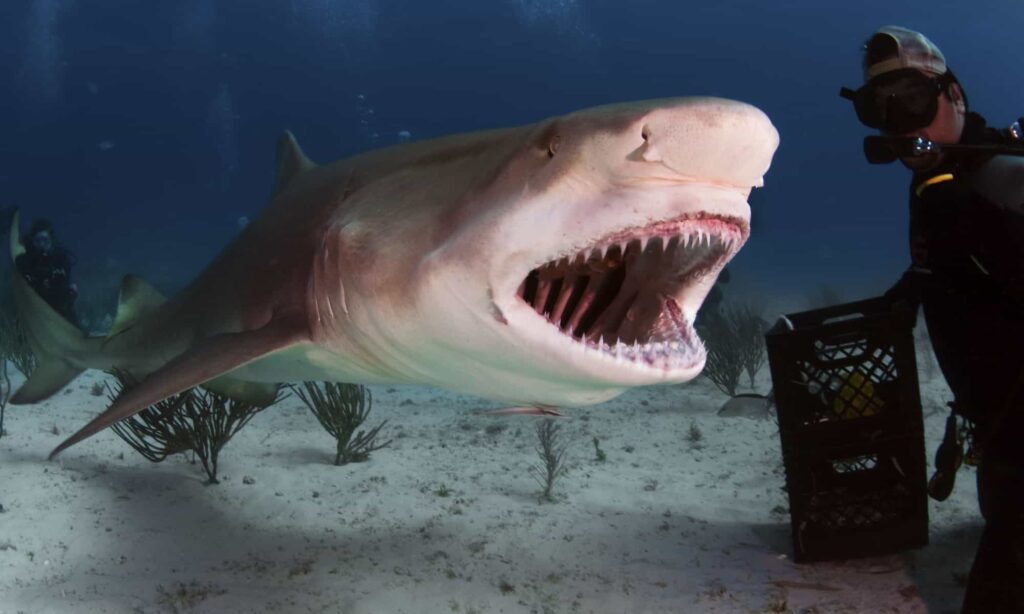Lemon Shark
N. brevirostis
Advertisement
Lemon Shark Scientific Classification
- Kingdom
- Animalia
- Phylum
- Chordata
- Class
- Chondrichthyes
- Order
- Carcharhiniformes
- Family
- Carcharhinidae
- Genus
- Negaprion
- Scientific Name
- N. brevirostis
Read our Complete Guide to Classification of Animals.
Lemon Shark Conservation Status
Lemon Shark Facts
Lemon Shark Physical Characteristics
- Color
- Grey
- White
- Skin Type
- Smooth
- Top Speed
- 7 mph
- Lifespan
- Up to 27 years
- Weight
- Around 220 pounds
- Length
- 8-10 ft
- Age of Sexual Maturity
- Around 12-13 years
- Venomous
- No
- Aggression
- Low
View all of the Lemon Shark images!
The Lemon Shark is a vulnerable species commonly found in subtropical waters. They return to the same nursery sites to breed and have electroreceptors that help them hunt fish. They are one of the few sharks known to live in groups.
5 Lemon Shark Facts
- Nursery sites: These sharks return to the same location each year to breed. Typically, it is thought to be the same locations where the adults were born.
- Group living: This species is one of the few sharks that live in groups – at least occasionally. They take part in many group behaviors, like courtship.
- Non-threatening: These sharks are extremely non-threatening to humans. Only ten bites have ever been reported, and none were serious.
- Long reproductive cycle: These sharks have a very long reproduction cycle. Females require a year for gestation and then another year to prepare for gestation.
- Famous sharks: The most famous population is sharks is likely the Lemon Shark population off the coast of the Bimini Islands.
Classification and Scientific Name
The Lemon Shark is part of the Negaprion genus. This genus contains two species, one of which is the Lemon Shark. The other shark is the Sicklefin Lemon Shark of the Indo-Pacific. Both of these sharks are very similar, though they inhabit different areas.
The Lemon Shark is also classified as a requiem shark, which contains 60 species and 12 genera. These sharks are migratory and give birth to live young.
They are in the order carcharhiniformes, which contains over 270 species and is the largest order of sharks. These sharks have two dorsal fins, an anal fin, and five-gill slits.
Lemon Shark Appearance
As their name suggests, lemon sharks have a slight yellow coloration. This color helps them blend into the sandy floor of their coastal habitat, which prevents them from being eaten by bigger sharks and helps them catch fish.
Typically, these sharks grow to be between 7.9 to 10.2 feet long. They usually weigh around 200 pounds by adulthood. However, some sharks can grow to be much larger. For instance, fishers have caught lemon sharks that weigh over 400 pounds and measured over 11.3 feet.
Furthermore, these sharks have flattened heads. Their short, broad snout helps them catch fish in their coastal waters. Usually, they have two dorsal fins that are about the same size as each other.
Like most lemon sharks, these have electroreceptors on their head and dorsal fin. These receptors help them detect fish. Because these sharks hunt mostly at night, they must detect their prey through methods other than sight.

Rather than rely solely on sight, lemon sharks have electroreceptors in their on their head and dorsal fin that help them detect fish — i.e. food.
©Greg Amptman/Shutterstock.com
Distribution, Population, and Habitat
While these sharks are only found in tropical waters, you can find them from the waters of New Jersey to southern Brazil. Sometimes, you can even spot them in the western areas of the Atlantic Ocean. Lemon sharks live in the eastern Pacific, such as in Baja, California, and Ecuador.
Usually, you’ll find lemon sharks in the same area as their prey. They prefer coral reefs, enclosed bays, river mouths, and similar locations. They only live to a depth of around 300 meters.
Technically, lemon sharks can live in freshwater. However, humans rarely find them very far into freshwater like rivers. Some experts believe they aren’t great hunters in more enclosed areas like rivers.
Usually, these sharks star around the continental shelves for most of their life. However, migrating sharks can be seen in open waters.
Scientists have studied the lemon shark’s habitat selection process in-depth, as they are among the few social sharks. They prefer warmer waters because it benefits their metabolism. However, they will also prefer areas where larger sharks are not located, reducing the risk of becoming eaten.
Predators and Prey
Lemon sharks are relatively small, so their prey usually mirrors their size.
What do lemon sharks eat?
Unlike other shark species, lemon sharks stay within an enclosed area. Therefore, scientists can figure out their diet easily, as they know exactly what fish will be found within each shark’s home range. For the most part, these sharks eat fish. They primarily feed at night, using their electroreceptors to locate prey.
However, researchers have also observed lemon sharks eating crustaceans and similar animals. Sometimes, larger lemon sharks will prey on smaller lemon sharks. For this reason, smaller sharks often reside in shallower waters where larger sharks cannot be found. As sharks get larger, they travel into deeper waters, as the odds of predation are lower.
When conditions are favorable, lemon sharks are quite particular about what they eat. They show a strong preference for certain species and may even settle in an area due to an abundance of that species. Sharks typically only eat each other when other prey items are scarce. Usually, lemon sharks feed exclusively on fish that are slower and easier to catch.
However, the exact species fed upon will depend on the area, as fish species do vary throughout this specie’s range. For instance, in the Bahamas, lemon sharks prefer parrotfish and mojarras. These species of fish use camouflage instead of escaping quickly from predators. Therefore, lemon sharks catch them easier.
Reproduction and Lifespan
The Lemon Shark has a unique reproduction process using nursing grounds. These sharks only mate in special mating grounds, chosen for their abundance of food and the likelihood of the pups surviving. Females return to the waters they were born in when it is time to have their pups.
Typically, lemon shark pups stay in this nursery area for a few years before venturing into deeper waters.
These sharks produce live young, and the mothers transfer nutrients to the fetuses through a yolk-sac placenta. Therefore, these sharks produce pups very similar to how humans produce babies.
Fertilization occurs internally. However, it isn’t odd for a female to accept breeding from multiple males. In some species, this occurs because it provides genetic benefits to the offspring. However, lemon shark females apparently accept breeding from multiple males out of convenience alone.
It takes a long time for one female to produce a pup. First, it takes a year for the female to produce an egg and yolk sack. Then, after breeding, gestation takes another year. Therefore, lemon sharks can only have one litter of pups every two years. Usually, each litter has no more than 18 pups.
Furthermore, lemon sharks also take a long time to reach maturity. Females are not ready to breed until 12-16 years of age. However, males do hit puberty sometime before females do.
Lemon Sharks in Fishing and Cooking
Both commercial and recreational fishers target lemon sharks throughout their range. Humans prize this species for their meat, fins, and skin. In some cultures, their meat is considered a delicacy. However, they are not regularly eaten due to their high price.
Still, this high price has led to over-fishing in some areas, especially along the western North Atlantic and the eastern Pacific. In these areas, the lemon shark population is declining. Today, the species overall is rated as vulnerable.
Up Next:
10 Incredible Shark Facts
5 Shark-Infested Waters to Avoid
6 Sharks With the Weirdest Adaptations
Lemon Shark FAQs (Frequently Asked Questions)
Are lemon sharks rare?
While these sharks may be rare in some areas, they are considered vulnerable. Therefore, there are many of them left, and they are not nearly as rare as other species. Typically, they hang out near the continental shelf, as they prefer shallower waters. Therefore, you may see them more often than other sharks.
Can you pet a lemon shark?
Petting wildlife is never recommended. While lemon sharks are not aggressive, they will bite if they feel threatened. Therefore, it is not recommended that you attempt to touch one. As sharks, lemon sharks do have very large teeth that are made for biting and shearing. Therefore, we recommend giving these sharks a proper amount of space if you see one in the wild.
Will lemon sharks attack humans?
Lemon sharks do not regularly attack humans. Only 10 bits have been reported throughout history. Furthermore, none of these bites were serious and did not lead to fatalities. Therefore, experts typically consider lemon sharks to be harmless.
Are lemon sharks aggressive?
No. These sharks aren’t known for being aggressive and rarely bite humans. Because they live in family groups, they are not territorial. While these sharks are larger, they only eat fish and typically feed at night. Therefore, the chance of them accidentally biting a human is considerably low.
Why do they call it a lemon shark?
These sharks have a slightly yellow color to blend into the sandy floor of the tropical oceans they inhabit. Therefore, they have been named lemon sharks because of this coloration.
Thank you for reading! Have some feedback for us? Contact the AZ Animals editorial team.
Sources
- Wikipedia, Available here: https://en.wikipedia.org/wiki/Lemon_shark
- Oceana, Available here: https://oceana.org/marine-life/lemon-shark/
- Florida Museum, Available here: https://www.floridamuseum.ufl.edu/discover-fish/species-profiles/negaprion-brevirostris/
- American Oceans, Available here: https://www.americanoceans.org/species/lemon-shark/

















